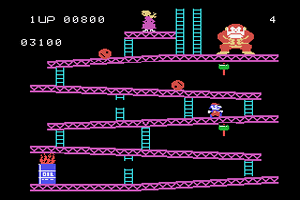| |
Coleco's software approach was to go after licensed arcade games that Atari had missed and to make cartridges for the 2600 and Intellivision in addition to its own system. Realizing that Atari had firm support from Namco (creators of Pac-Man and many other hits), Coleco involved itself with companies like Sega, Konami, and Universal. The ColecoVision had enough power to produce near-arcade-quality ports, and industry magazines like Electronic Games were unanimous in their enthusiasm over the console.
Some of the more popular games included Donkey Kong (the pack-in), Donkey Kong Junior, Carnival, Lady Bug, Mouse Trap, Smurfs: Rescue in Gargamel's Castle, and Zaxxon. The ColecoVision didn't offer many revolutionary new games, since most of its popular titles were arcade ports. Still, it did offer a few notable original titles like War Room, Illusions, and Fortune Builder, an early milestone in the style of SimCity. Most cartridges did not have an end-game to beat, but instead would loop around to the beginning, such as Cosmic Avenger.
Coleco also popularized less popular arcade games, such as Venture, the aforementioned Cosmic Avenger and Lady Bug, as well as Mr. Do!. In some cases, the console versions were arguably superior to the arcade versions, as seen in Space Panic. |
|
|








